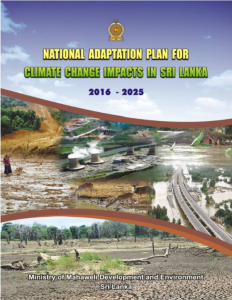Sri Lanka’s National Adaptation Plan for Climate Change Impacts (NAP) was prepared in line with the broad set of guidelines set forth by the United Nations Framework Convention on Climate Change (UNFCCC) for the development of national adaptation plans.
The NAP process of UNFCCC is a generalized process consisting of four stages that could be customized according to specific situations in respective countries.
The NAP process in Sri Lanka started from the stage of preparatory elements, which is the real planning stage of the process, and a country-specific NAP methodology was developed and adopted based on the broader guidelines of the UNFCCC.
The importance of adaptation as a major strategy for facing the threat of climate change has been recognized by all parties to Paris Agreement and called for national actions for adaptation under Intended Nationally Determined Contributions (INDCs).
The necessity of adaptive strategies have also been highlighted by a number of Sustainable Development Goals (SDGs) adopted by the United Nations in 2015.
The NAP covers adaptation needs at two levels, namely; adaptation needs of key vulnerable sectors and cross cutting national needs of adaptation. Nine vulnerable sectors were identified in the consultative process, i.e. food security, water, coastal sector, health, human settlements, bio-diversity, tourism and recreation, export development and industry- energy-transportation.
Broader stakeholder consultation adopted in the preparation of the NAP has helped to identify adaptation needs of each vulnerable sector based on logical criteria involving projections, vulnerabilities, impacts and socio-economic outcomes.
The NAP identifies adaptation options that can fulfill these needs and actions necessary to achieve these adaptation options with responsible agencies and key performance indicators. They together constitute the sectoral action plans for each vulnerable sector.
The NAP also includes interventions necessary to fulfill cross-cutting national needs of adaptation identified on the basis of analyzing common sectoral needs and opinions of key stakeholders. The plan also proposes an institutional and coordination mechanism along with implementation and resource mobilization strategies for the successful implementation of the NAP based on a realistic timeframe.
The Plan was retrieved from the Ministry of Environment and was published in 2016.
Help SAR-Climate keep this document page accurate and updated by suggesting an edit or any corrections here.

